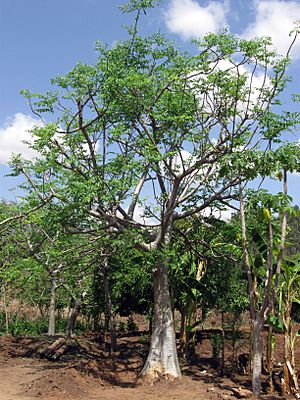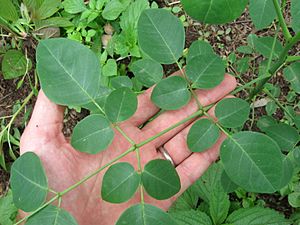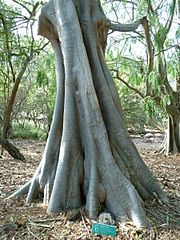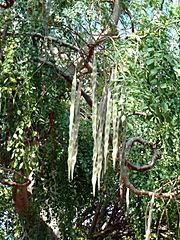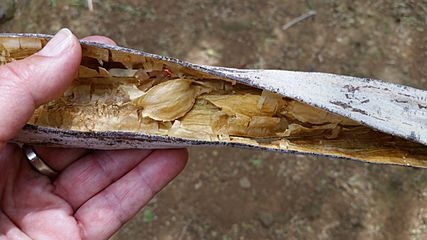African Moringa facts for kids
Quick facts for kids African Moringa |
|
|---|---|
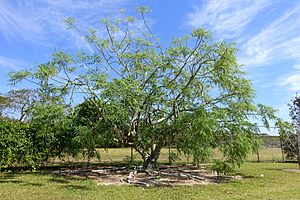 |
|
| A specimen at the Fruit and Spice Park in Redland, Florida | |
 |
|
| Flowers and leaves, photographed on Oahu, Hawaii | |
| Scientific classification | |
| Genus: |
Moringa
|
| Species: |
stenopetala
|
| Synonyms | |
|
|
Moringa stenopetala, often called the African Moringa or cabbage tree, is a tree that loses its leaves. It belongs to the Moringa plant group and grows naturally in Kenya and Ethiopia. This tree can survive in dry places. It has a trunk shaped like a bottle, long twisted seed pods, and leaves you can eat. People say the leaves taste like cabbage, which is how it got its common name. In Ethiopia, M. stenopetala no longer grows wild, but people still plant it as a crop on farm terraces in the Ethiopian Highlands, especially in the Konso region.
Like its well-known relative, M. oleifera, Moringa stenopetala is a very useful tree. Its leaves, pods, and flowers are all edible and full of nutrients. The seeds contain a fragrant oil used in cooking and beauty products. The leftover seed material or powdered bark can even help clean water. This tree is used in many dishes and has a long history in traditional healing in the areas where it grows.
Contents
How the African Moringa Got Its Name
This tree was first described in 1896 by a botanist named Edmund Gilbert Baker. He called it Donaldsonia stenopetala. Later, another scientist, Emilio Chiovenda, found a similar plant in Kenya and named it Moringa streptocarpa. In 1957, Georg Cufodontis realized these were the same plant. He officially named it Moringa stenopetala. The name stenopetala comes from Greek words meaning "narrow" and "petal," because of its narrow petals.
M. stenopetala is part of the Moringa group, which is the only group in the Moringaceae plant family. Scientists divide Moringa species into different types. M. stenopetala is in a group with other trees like M. drouhardii. These trees have winged seeds and flowers that are mostly regular in shape.
People in its native regions have many different names for M. stenopetala. For example, it's called (h)aleko in the Gidole language and shelagda or telchada in the Konso language. In English, it's usually known as the African Moringa or cabbage tree.
What the African Moringa Looks Like
Moringa stenopetala is a tree that lives for many years. It has a rounded, bushy shape and usually grows 6 to 12 meters (about 20 to 40 feet) tall. Sometimes, it can reach 15 meters (about 50 feet). Its trunk is wide at the bottom, like a bottle, and often splits into branches. The trunk can be up to 1 meter (about 3 feet) wide. The bark is smooth and light gray or silver. The top of the tree has many branches. Young branches are covered in soft, dense hairs.
The leaves are light green when they are fully grown and can be up to 55 centimeters (about 22 inches) long. They are attached to the stem by short stalks. Each leaf has many smaller leaflets, usually three to nine on each section. These leaflets are about 3.5 to 6.5 cm long and 2 to 3.5 cm wide. They are oval-shaped with a pointed tip. Small, sweet-smelling glands are often found at the base of the leaves.
The flowers of M. stenopetala grow in large, fragrant clusters up to 60 cm (about 2 feet) long. Each flower has both male and female parts and is round. The outer parts of the flower (sepals) are cream-colored, sometimes with a pink tint. The petals are white, pale yellow, or yellow-green and are about 8 to 10 mm long. Each flower has five stamens (male parts) with white filaments and yellow anthers. The ovary (female part) is hairy and oval-shaped.
The fruits are long pods, about 19.7 to 50 cm (about 8 to 20 inches) long and 1.8 to 4 cm (about 0.7 to 1.6 inches) wide. Young pods are bright green, turning reddish as they ripen. When mature, the pods split open into three parts, releasing up to 20 seeds. The seeds are oblong or triangular, about 2.5 to 3.5 cm long, and covered by a papery, winged husk. Inside, the kernel is smooth and whitish-grey.
Where the African Moringa Lives
Moringa stenopetala is found in a few places in the Horn of Africa. It grows naturally in southern Ethiopia and northern Kenya, and possibly in Somalia. There are not many wild populations left, but some have been found in the Kenyan Rift Valley. For example, it grows on Ol Kokwe Island in Lake Baringo and around Lake Turkana. People have also planted M. stenopetala in other parts of tropical Africa, from Senegal in the west to Malawi in the south.
In the wild, M. stenopetala grows in different environments, from 400 to 1,200 meters (about 1,300 to 3,900 feet) high. It prefers dry or semi-dry areas, getting about 500 to 1,400 mm (20 to 55 inches) of rain each year. Average temperatures are between 24 and 30 °C (75 and 86 °F). Wild trees are often seen near water, in drylands, shrublands, and woodlands. They can grow with other plants like Acacia tortilis. These areas usually have rocky or sandy soils that drain well. The tree is known for being able to grow in many different soil types, even harsh ones. Mature trees can even make the soil around them more fertile by dropping lots of organic material.
Like other African Moringa plants, M. stenopetala is good at handling the intense heat and drought in its native lands. If it has some shade, it can survive temperatures up to 48 °C (118 °F). Its thick roots and swollen trunk store water, helping it thrive in dry climates. Even though it loses its leaves during very long dry seasons, it usually stays green all year in milder conditions. It can handle light frost, but long periods of cold can make it wither.
M. stenopetala trees can live for 60 to 100 years and keep producing leaves and fruits for a long time. They grow quickly. Young plants can reach 3 meters (10 feet) in their first year and start producing flowers and fruits after about 2.5 years. After that, they often flower and fruit all year long. The flowers have a sweet smell that attracts birds and insects, which help with pollination. Wind or water can spread the mature seeds. The leaves provide good food for both wild and farm animals, and the flowers are an important source of nectar for honeybees.
How People Grow the African Moringa
Farmers in the Ethiopian Highlands planted Moringa stenopetala on their complex terraces. They grew these trees to make them more productive, improve the taste of their leaves, and increase seed size. These improved trees have since been introduced to other areas, like the Kenyan Rift Valley.
Today, in Ethiopia, M. stenopetala is very important as a nutritious vegetable crop. It is grown in the terraced fields of Konso for its leaves and pods. It's easiest to grow new plants from seeds. However, plants grown from cuttings (pieces of the plant) might flower and fruit sooner, sometimes within a few months. Seeds should be planted 1 to 2 cm deep in soil that drains well and kept moist in full sun. They usually sprout about a week after planting. For the best growth, temperatures should be between 15 °C (59 °F) and 33 °C (91 °F). This matches elevations of 1,150 to 1,800 meters (about 3,775 to 5,900 feet). Farmers can start collecting leaves and fruits after two years, but traditional farmers often wait 5 to 6 years before harvesting.
Eating the African Moringa
The leaves, seeds, flowers, and young pods of M. stenopetala can all be eaten. They are common ingredients in dishes where the tree grows. More than 5 million people are thought to eat M. stenopetala regularly. It is especially popular among different groups in Ethiopia's SNNP Region.
Leaves
Like M. oleifera, the leaves of M. stenopetala are very nutritious. A study of Ethiopian leaves showed that 100 grams of dry leaves contain about 28.44 grams of protein, 0.7 grams of fat, and 38.49 grams of carbohydrates. They also provide 11.62 grams of fiber and about 274 kcal of energy. Fresh leaves are rich in vitamin C (28 mg per 100g) and a good source of vitamin A. They also have many important minerals like calcium, iron, and phosphorus. Among Moringa species, M. stenopetala leaves have the most sulfur and are very rich in protein. The amount of nutrients can change depending on the season, where the plant grows, and the type of soil. During the dry season, an adult in southern Ethiopia might eat 150 grams of fresh leaves daily. This provides 19% of their energy and 30% of their protein needs.
The taste of the leaves can be bitter or sweet, and it can even vary from tree to tree. People say the taste is better during the dry season. The small leaflets are taken off the main stem and eaten either raw or cooked like cabbage. This is why it's called the "cabbage tree." They can be served with bread to make meals more nutritious. In the Konso region of Ethiopia, people often boil balls of mixed flours (sometimes with cereals) in salt water and serve them with the leaves. The Siltʼe people use cornmeal as the main flour and add onions and chilies to make a dish called kurkufa. In another version, called fosesae, cornmeal is mixed with water to make a dough, then cooked with the leaves and spices. Dried, crushed leaves can also be added to chegga, a traditional sorghum drink of the Dirashe people.
Other Edible Parts
The fruits are a bit bitter, even when young, so they are usually prepared only when other food is hard to find. The flowers can also be boiled or eaten fresh. The seeds produce a fragrant, edible oil. This oil can be used for cooking or as a dressing for salads.
Other Ways People Use the African Moringa
This tree is used to provide shade for crops like Capsicum (peppers) and Sorghum. It is also planted alongside other crops to help them grow better. A survey in 2015 found that most families in Derashe and Konso villages grow M. stenopetala trees. They have been doing so their whole lives. Everyone surveyed had eaten the tree as food, many relied on it for income, and some used it for traditional healing.
Another important use is to clean and purify water, making it safe to drink. A powder made from grinding the seeds is very good at clumping together substances in water. This makes the water clearer. This powder works even better than seeds from M. oleifera, which is used for water purification in India. When powdered, the tree bark can also absorb things, which might be useful in cleaning water from factories.
Traditional Healing
M. stenopetala has been used in traditional healing for a long time in the areas where it grows. The Ilchamus people of Kenya chew or boil the roots to help with coughs and to feel stronger. Among the Turkana people, people with leprosy drink a special liquid made from the leaves. In southern Ethiopia, people boil crushed roots or leaves in water and drink it as a herbal remedy for different problems like malaria, diarrhea, and dysentery. The Konso people make a tea or extract from the dried leaves, believing it helps with breathing problems. The Dirashe people might put sap from the branches and leaves on their skin to help with hygiene.
Research on African Moringa
Like its related species M. oleifera, Moringa stenopetala is being studied by scientists. They want to find out if it has special properties that could help people. Its possible effects in humans are still being researched and are not yet confirmed.
Gallery



